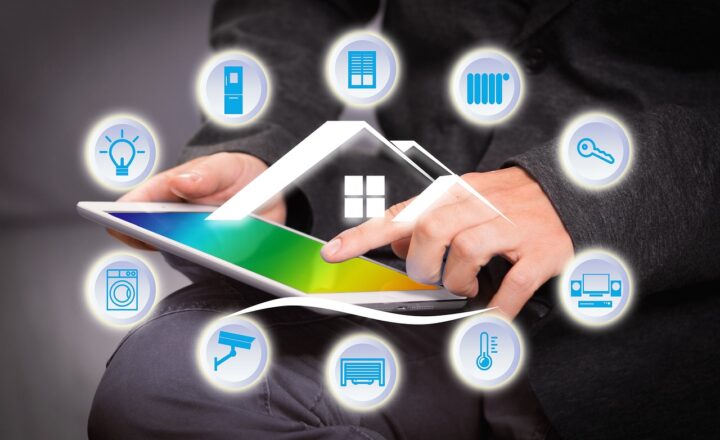The Evolution of Smart Homes: How Technology is Redefining Modern Living
October 19, 2024

The concept of the “smart home” has evolved dramatically in recent years. What was once a futuristic vision depicted in science fiction movies has now become an integral part of many households around the world. From voice-controlled devices to automated lighting systems, smart homes are redefining modern living, offering convenience, security, and energy efficiency. This article will explore how smart home technology has evolved, the innovations driving its growth, and what the future holds for this rapidly expanding industry.
1. What is a Smart Home?
A smart home refers to a residence that uses internet-connected devices to control and automate various household systems, such as lighting, heating, security, and entertainment. These devices are typically controlled through a central system, like a smartphone app or a voice-activated assistant, allowing homeowners to manage their homes remotely.
The goal of a smart home is to improve the quality of life by providing greater convenience, enhanced security, and more efficient energy usage. From turning on the lights when you walk into a room to adjusting the thermostat based on your preferences, smart homes are all about creating a more personalized living experience.
2. The Evolution of Smart Home Technology
The journey of smart home technology can be traced back to the early days of home automation, where systems were designed to control a limited number of devices. However, with the rise of the Internet of Things (IoT), smart homes have undergone a significant transformation.
Early Home Automation
Home automation systems first emerged in the 1970s and 1980s. These systems allowed homeowners to control devices like lights and thermostats using basic timers and sensors. While innovative for their time, these early systems were limited in scope and often required professional installation.
The Introduction of IoT
The real breakthrough in smart home technology came with the advent of IoT in the late 2000s. IoT refers to the network of devices connected to the internet that can communicate with each other. This enabled a new level of automation, where devices like refrigerators, cameras, and even door locks could be connected and controlled remotely.
Voice Assistants: A Game Changer
The introduction of voice-activated assistants like Amazon Alexa, Google Assistant, and Apple’s Siri in the mid-2010s revolutionized the smart home industry. These virtual assistants made it easier for homeowners to control their devices simply by speaking, further enhancing the convenience and accessibility of smart home technology.
3. Key Features of a Modern Smart Home
Today’s smart homes are equipped with a wide range of devices and systems designed to make life easier, more secure, and more efficient. Here are some of the key features that define modern smart homes:
1. Voice-Activated Assistants
Virtual assistants like Alexa and Google Assistant serve as the central hub for many smart homes. They can perform tasks like turning on lights, setting alarms, playing music, and even ordering groceries. With the ability to control multiple devices through simple voice commands, these assistants have become an essential part of the smart home ecosystem.
2. Smart Lighting
Smart lighting systems allow homeowners to control their lights remotely or set schedules for when they should turn on and off. Some systems can even adjust the brightness and color of the lights based on the time of day, creating a more comfortable atmosphere while saving energy.
3. Security Systems
Smart security systems have become increasingly popular in recent years. These systems include features like smart doorbells with cameras, motion sensors, and remote-controlled locks, all of which can be monitored and controlled via smartphone apps. Some systems even come with facial recognition technology, allowing homeowners to identify visitors before granting them access.
4. Smart Thermostats
One of the most widely adopted smart home devices is the smart thermostat. These thermostats can learn your heating and cooling preferences and automatically adjust the temperature to optimize comfort and energy efficiency. Many models can be controlled remotely, allowing you to adjust the temperature even when you’re not at home.
5. Smart Appliances
From refrigerators that can track your groceries to washing machines that send notifications when the laundry is done, smart appliances are becoming increasingly sophisticated. These devices not only offer convenience but also help homeowners save time and reduce energy consumption.
4. Benefits of Smart Homes
Smart home technology offers numerous benefits that go beyond convenience. Here’s how it can improve modern living:
1. Energy Efficiency
One of the biggest advantages of smart homes is the potential for energy savings. Smart thermostats, lighting systems, and appliances can optimize energy usage, reducing both electricity consumption and utility bills. Many devices also provide real-time data on energy usage, helping homeowners make more informed decisions.
2. Enhanced Security
Smart security systems provide peace of mind by allowing homeowners to monitor their property remotely. Whether it’s receiving notifications when someone rings the doorbell or viewing live footage of your home’s surroundings, these systems offer a level of security that traditional systems can’t match.
3. Convenience
The ability to control devices from a smartphone or through voice commands makes daily tasks more manageable. Whether you’re adjusting the thermostat while lying in bed or turning off the lights from your car, smart home technology offers unprecedented convenience.
4. Customization
Smart homes can be tailored to meet the unique needs and preferences of each homeowner. From setting schedules for your devices to creating personalized lighting schemes, the level of customization available in a smart home allows for a truly personalized living experience.
5. Challenges and Concerns with Smart Homes
While the benefits of smart homes are clear, there are also several challenges and concerns that need to be addressed as the technology continues to evolve.
1. Privacy and Data Security
With smart devices constantly collecting data, there are valid concerns about privacy and security. Hackers can potentially gain access to a homeowner’s network and control their devices or steal sensitive information. It’s essential for homeowners to take steps to secure their networks and devices, such as using strong passwords and regularly updating their software.
2. Compatibility Issues
Not all smart devices are compatible with each other. Different manufacturers use different platforms, which can lead to frustration when trying to integrate multiple devices. However, companies are starting to adopt more universal standards like Matter, a protocol that aims to improve device compatibility across brands.
3. Cost
While the price of smart home devices has decreased in recent years, outfitting an entire home with smart technology can still be expensive. Homeowners need to weigh the costs against the potential benefits, such as energy savings and increased security.
4. Reliability
Smart devices rely on internet connectivity to function properly. If your internet goes down, many of your smart home features will become unavailable. Additionally, some devices can experience glitches or malfunctions, requiring technical troubleshooting.
6. The Future of Smart Homes
As technology continues to evolve, so too will the capabilities of smart homes. Here are some trends to watch for in the coming years:
1. Integration of AI
Artificial intelligence will play an even bigger role in the future of smart homes. AI will enable devices to anticipate homeowner needs more accurately, from adjusting lighting based on your mood to preparing your home for your arrival after work.
2. Greater Focus on Sustainability
With climate change becoming an increasingly urgent issue, future smart homes will likely focus more on sustainability. This could include more energy-efficient appliances, smarter water usage systems, and homes that generate their own renewable energy.
3. Health and Wellness Integration
As smart technology expands, we can expect to see more integration with health and wellness systems. Devices that monitor air quality, track sleep patterns, and even provide health alerts will become more common, helping homeowners maintain a healthier lifestyle.
Conclusion: The Smart Home Revolution
The smart home revolution is well underway, and its impact on modern living cannot be overstated. From energy savings and enhanced security to increased convenience, smart homes offer a range of benefits that make everyday life easier and more efficient. While challenges like privacy concerns and compatibility issues remain, the future of smart homes looks bright as technology continues to advance. For homeowners looking to embrace the future, there has never been a better time to start building a smart home.








